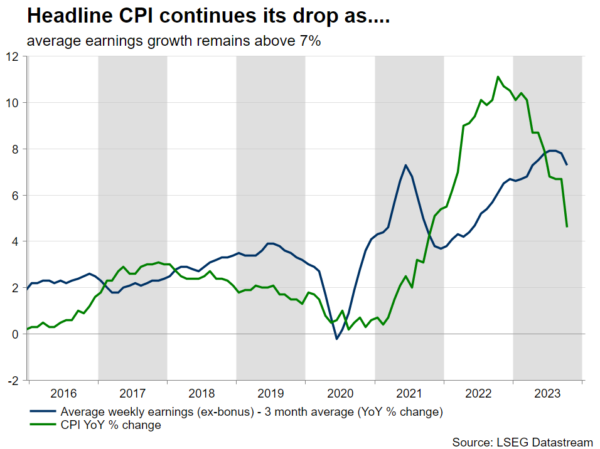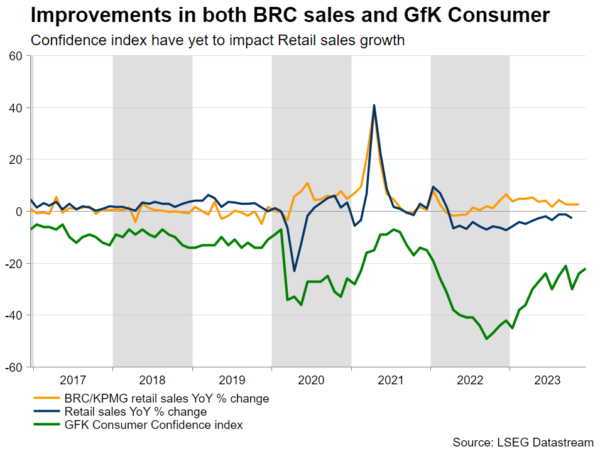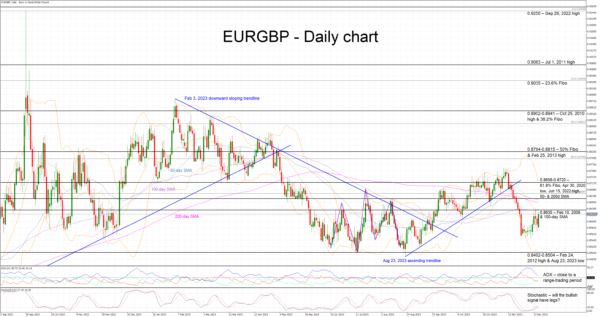- Market recovering from Thursday’s relatively hawkish show by the BoE
- Pound would benefit against the euro from an upside CPI surprise
- November inflation report will be released on Wednesday (07.00 GMT)
A surprisingly hawkish BoE last week
Contrary to market expectations and the Fed setting the scene for a dovish round of central bank gatherings, the Bank of England did not pivot at last week’s meeting. Somewhat surprisingly, three BoE members continue to vote for another 25bps rate hike and thus influencing the overall rhetoric of the accompanying statement.
There was no press conference, but Governor Bailey’s post-meeting comments were supposed to be a cold shower for the ballooning market expectations for rate cuts. However, the market appears to have set its mind as 110bps of easing are expected by the BoE in 2024, considerably less than the 150bps of rate cuts anticipated by the neighbouring ECB, and despite similar efforts from ECB members to dent the market’s aggressive rate cut hopes.
Data releases continue to matter
This situation is unlikely to change soon unless data turns negative very quickly. Therefore, data releases still hold all the cards. Last week finished on a mixed note as the stronger Services PMI was overshadowed by the weaker Manufacturing PMI survey. The latter was not completely unexpected as there is continued weakness in the sector as confirmed by the recent manufacturing production data. We also have to include the impact of the recent political cabinet reshuffle – investment-hungry sectors like manufacturing dislike political uncertainty – and the weaker growth sentiment seen in the euro area.
Moving to this week and the November inflation report is the key event. We have to acknowledge that since the next BoE meeting will be held on February 1, which will include the quarterly Monetary Policy Report, there will be another inflation report in mid-January 2024. Having said that, every data point matters, especially in the current period of lower liquidity as we are getting very close to the festive period.
The headline CPI is forecast to slow further to a 4.4% year-on-year growth, while the core indicator is also expected to edge lower to 5.5%. These inflation levels are clearly not associated with a central bank assumed to be on the brink of embarking on an aggressive easing campaign unless growth falls off a cliff. The final GDP print for the third quarter of 2023 will be published on Friday but it is unlikely to have market impact and would be treated as “old news”.
Adding to the hawkish evidence and with average earnings growth remaining north of 7%, retail sales are expected to improve from low levels. This trend will probably persist during the traditionally spending-heavy festive period. In this context, on Friday, the November print for retail sales is expected to show a -1.8% year-on-year growth with the improvement possibly being stronger in the retail sales ex-fuel indicator.
Pound could benefit from a stronger inflation report
On the back of the aggressive build-up of rate cut expectations by the ECB, the pound managed to outperform the euro since mid-November, pushing the euro/pound pair to a new 3-month low. However, this outperformance appears to have run out of gas following the unexpected hawkishness exhibited by the ECB at last week’s meeting.
Focusing on this week and another small downside surprise in the UK inflation report could open the door for a more protracted move higher towards the busy 0.8658-0.8720 area. On the flip side, stronger inflation prints, especially in the case of the core CPI component, would somewhat unsettle market expectation, allowing the euro/pound pair to stage a move towards a new 3-month low, below the recent 0.8548 print.














